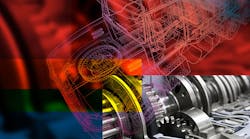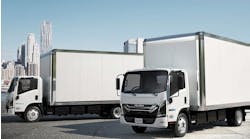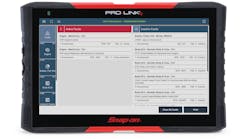The digital transformation appears close to killing the manual truck transmission. Over the past decade, the trucking industry has discovered that automatic transmissions are better than humans at reliably and accurately performing precisely timed motions. While it’s debatable that computers will ever autonomously operate the whole truck, no one can argue they have the gear-shifting gig well under control.
“The age of manual transmissions … is slowly coming to a close,” said Roy Horton, director of product strategy for Mack Trucks.
Horton said about 94% of orders for Mack’s highway flagship Anthem model are now spec’d with the mDrive automated manual transmission, and there is a similar trendline across other models. He suggested it may only be “a few more years” before the only manual transmissions in trucks are generally those trying to keep it “old school.”
Similarly, Jason Skoog, general manager of Peterbilt Motors, suggested it is unlikely there will be many manuals a decade from now, though the manufacturer “lets customers decide what happens with our product portfolio.”
Manuals may be needed in certain vocational applications, but fleets are likely to order them “only if they absolutely need it,” Roger Nielsen, president and CEO of Daimler Trucks North America (DTNA), predicted.
Shifting of the guard
Whether it’s a fully automatic transmission (AT), which uses a torque converter, or automated manual transmission (AMT), which internally operates like a manual but shifts with computer-controlled actuators, these options are easier on drivers and equipment.
The modern automatic transmission is less a component on the truck than a co-pilot, using navigation, load data, and preset fleet standards to make sure the driver is comfortable and focused on the road while also ensuring smooth operation to reduce wear and achieve maximum fuel economy.
Not long ago, manual transmissions were the preferred choice based on economics: They cost less and provided good fuel economy. A 2015 Frost & Sullivan study found heavy-duty AMTs cost $1,000 to $5,000, and ATs cost $6,000 to $10,000 more than their manual counterparts. They made up for that by providing better fuel economy, with up to 8% for AMTs and 3% to 5% for ATs. That study predicted manual’s global share would decline to 65.5% by 2025, but the change came much sooner.
Back in 2012, Martin Daum, CEO of DTNA at the time, made it his “mission” to change a market using 90% manual transmissions. Daimler invested $100 million to manufacture the Detroit DT12 AMT, engineered to provide good fuel economy and a better user experience for the driver.
Numerous other truckmakers and suppliers made similar moves, and the Class 8 tractor was never the same again.
DTNA said 94% of new Freightliner Cascadias are being spec’d with automated manual transmissions and 5% manual. The other 1% are fully automatic.
An estimated 90% of all Volvo Trucks are being built with AMTs. Likewise, Navistar International said manuals have shrunk to a few percent, while Kenworth Truck’s linehaul builds with AMTs jumped from 30% in 2013 to about 70% in 2018.
Scott Barraclough, technology product manager at Mack Trucks, said manuals are now few and far between. He relayed how it takes about two days to evangelize loyal manual drivers try out the mDrive. “They were not difficult to convert,” Barraclough said. “Driving is believing.”
Because fewer and fewer drivers know how to drive stick, it also makes it easier to recruit and see better performance.
“There’s a 30% variability from driver to driver doing the same work,” said Kris Ptasznik, Cummins’ X15 product manager. “The driver impacts fuel economy a whole lot.”
Fleet owners strive for predictability to balance their budgets, and 30% variations make that pretty difficult to do. Mack’s Barraclough said this automated equipment helps achieve that standardization.
“An AMT normalizes your fleet and brings your worst driver up to the level of your best driver, because it’s doing the shifting for them,” he said. “It doesn’t have a bad day; it doesn’t get tired.”
Click here to subscribe to FleetOwner Newsline to get the latest updates on the trucking industry.
General benefits
Branden Harbin, managing director of global marketing at Allison Transmission, said the human element is the very reason automatics have become so necessary: The best, most experienced manual drivers are either retiring or switching to automatics due to 40 years of wear and tear on their knee ligaments.
“They’re extending their careers by moving to a fully automatic transmission in their vehicle,” he said.
Sandy Dunn, a driver for Otto Trucks, which hauls aggregate such as sand and dirt, said in a YouTube testimonial for Allison that “if you’ve driven a standard, we’re pushing on the clutch so many times before we even get through the intersection we can’t even count. My whole body hurts.”
That’s not the type of thing an industry hurting for drivers wants to spread around, and successful fleets understood that changes had to be made.
“We gotta do what makes employees happy, and a lot of that is making sure they got good equipment,” said Alan Otto, the company’s president.
Whatever the choice, these automated gearboxes reduce wear and tear, as having a machine and not a person engage the various gears leads to smoother coupling, with ATs being more smooth. This in turn spares the clutch, prolongs its life, and leads to more uptime.
Smarter transmissions
The newer crop of ATs and AMTs rely on sensor data and algorithms to match torque output to several factors such as the load and upcoming topography, like a steep hill. The results have been dramatic.
It all comes down to the application, but coding has a lot more to do with it than ever before.
“The software is the secret sauce,” said Anthony Truelove, Eaton vehicle group global marketing communications manager. “That’s where you can really improve drivability and efficiency with predictive shifting, so you’re staying in that sweet spot of the torque curve and the power range. That really makes trucks much easier to drive than they used to be—and much more car-like.”
Most potential truck drivers never learned to manually shift but are now still employable once they obtain an automatic-only commercial driver license. Simplified, but secretly technologically complex, driving also equates to safer roadways.
“The entire point of this is to be seamless and invisible to the driver so all they have to focus on is getting the job done right,” Harbin said. “This enables the driver to focus their full attention on the road versus needing to look down to shift gears or to be focused on other things beyond what’s in front of them in their mirrors.”
Allison Transmission’s Fuel Sense 2.0 DynActive shifting feature controls combined with the manufacturer’s xFE internal gear scheme boasts a potential 8% fuel economy improvement on the new 3414 Regional Haul Series, which will be available on Freightliner trucks in the spring.
On the AMT side, the Cummins-Eaton Endurant AMT paired with the 2020 X15 Efficiency Series engine claims to improve fuel economy by 5% over the previous 2017 offering.
Navistar recently announced all new LT and RH models, as well as the LoneStar, would come standard with the 1,850 lbs.-ft. capable Endurant. Manual and AT selections are still available upon request.
“In LT and RH models, this transmission provides the best fuel economy and longest service intervals from a lightweight design,” said Jim Nachtman, Navistar’s marketing director for the heavy-duty segment. “Over 70% of LT production in 2019 included an Eaton Endurant transmission, and that number is even higher in the RH Series,” he said.
Nachtman said a fleet could go five years and “never have to touch the transmission fluid.”
Eaton’s IntelliConnect also diagnoses and prioritizes fault codes to help fleets manage any downtime more efficiently in case, for example, the clutch does need replacing. There’s also a “limp home” mode that enables the transmission to work in a reduced capacity to get a driver to a service location.
“We made a really big step change in the drivability with Endurant,” said Charles Ganske, product management leader for the Eaton-Cummins joint venture.
“Predictive cruise control, when paired with an automated manual transmission like the Eaton Endurant, can improve fuel economy by up to 4% with the normal factory settings,” said Nachtman. “There’s more to be had from optional settings.”






